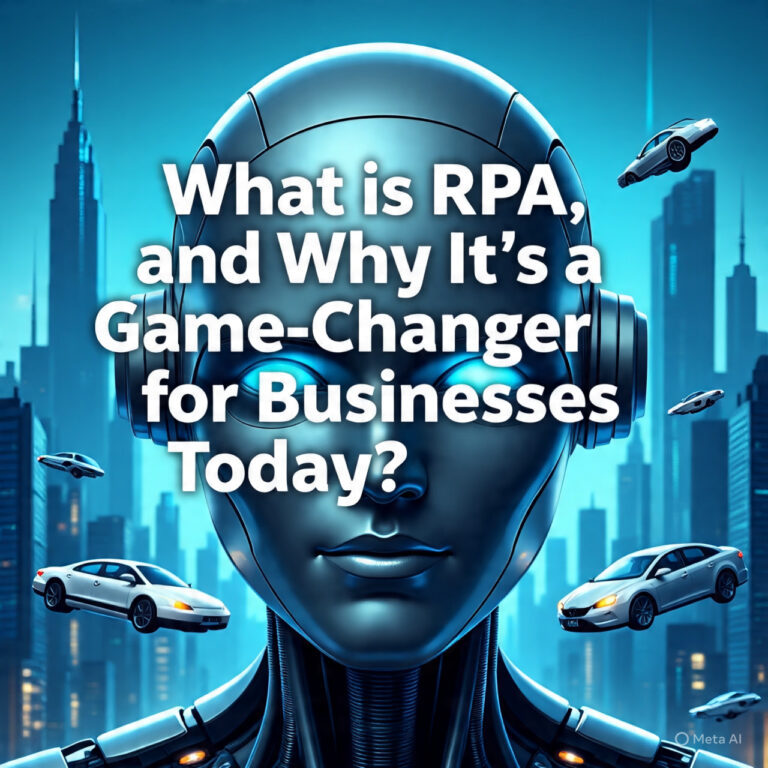With all the buzzwords flying around—AI, RPA, Intelligent Automation—it’s easy to get lost in the tech lingo. But what do these terms really mean for your business? And more importantly, how can they help you stay ahead in today’s ultra-competitive market?
In this article, we’ll break down these technologies in a fun, simple, and practical way, with examples to show how businesses like yours are using them to transform operations.
Let’s dive in! 🏊♂️
RPA: The Workhorse of Automation
Robotic Process Automation (RPA) is the superstar of routine, rule-based tasks. Think of it as a digital employee who excels at boring, repetitive tasks—no complaining, no sick days, just work, work, work.
Imagine an RPA bot as a virtual assistant that handles:
- Data entry
- Invoicing
- Processing orders
- Generating reports
For example, Walmart uses RPA to process millions of invoices every day. And they save thousands of human hours in the process—freeing up their team to focus on strategic decision-making instead of paperwork.
✅ Key takeaway: RPA is your best bet for automating simple, repeatable processes without human intervention.
AI: The Brain of Automation
Artificial Intelligence (AI) is like the brain behind automation. It’s designed to think, learn, and make decisions—almost like a human (but often faster and more accurately).
While RPA handles the “do,” AI handles the “think.”
Example: A bank uses AI to detect fraud by analyzing transaction patterns in real-time. If it spots something fishy 🐠, like a transaction from a new location, it flags it for review. It learns over time what’s normal and what’s not, constantly improving its accuracy.
AI can handle complex tasks like:
- Customer service chatbots that can actually understand your customers (not just spit out scripted responses).
- Predicting trends in your sales, helping you stay one step ahead of demand.
- Analyzing customer behavior to tailor your marketing strategies in real-time.
✅ Key takeaway: AI is your thinking partner that enhances decision-making, whether it’s predicting sales, automating customer interactions, or spotting fraud.
Intelligent Automation: The Best of Both Worlds
Now, Intelligent Automation (IA) is where things get exciting. IA combines the best of RPA and AI—the muscle of RPA with the brainpower of AI.
Think of it as automation with a twist of genius. It automates tasks but also learns, adapts, and makes decisions in the process.
For example, Amazon uses Intelligent Automation in its warehouses. RPA bots handle the heavy lifting (literally), moving packages from place to place. Meanwhile, AI manages inventory predictions, ensuring that products are always available without overstocking. This combination means fewer mistakes, faster processing, and happier customers.
Here’s what IA can do:
- Automate customer support using AI-powered bots that learn from conversations to offer even better service next time.
- Smart decision-making—automating the approval of loans by analyzing data, reviewing risk, and even identifying patterns in customer behavior.
- Real-time response—from approving invoices based on previous patterns to optimizing supply chain logistics, all while learning and adjusting on the fly.
✅ Key takeaway: Intelligent Automation blends AI and RPA to create smarter, more adaptable automation that evolves as your business grows.
Which Should Your Business Use?
Here’s where it gets fun. It’s not an either-or scenario; you can mix and match based on your business needs!
- If you want to automate repetitive, rule-based tasks like processing invoices or generating reports: start with RPA.
- If you need help making predictions, optimizing processes, or offering personalized experiences: leverage the power of AI.
- If you want automation that can learn and adapt over time, reducing human involvement while getting smarter: welcome to the future with Intelligent Automation.
So, Why Does This Matter for CEOs, Managers, and Business Owners?
Because the future of work is smart. It’s agile. It’s about getting the most out of your resources, freeing your team to focus on strategy, innovation, and growth.
⚡ Businesses that don’t embrace automation now may find themselves struggling to keep up with those that do. ⚡ Those that do can expect to see cost reductions, fewer errors, faster service, and a competitive edge.
Think about this: one insurance company used RPA to process claims in seconds—something that used to take 30 minutes per claim. Imagine what that could mean for your bottom line.
Final Thoughts: Embrace the Bots, Lead the Change
Automation is no longer just a tool; it’s a business strategy. And whether you’re looking to save on operational costs, scale your business, or boost customer satisfaction, RPA, AI, and Intelligent Automation have a role to play.
The key is knowing where to start—and with which tools. The smartest businesses are embracing a combination of these technologies, creating workflows that are not just faster, but smarter.
Let’s automate the mundane so your team can focus on changing the world.
Ready to dive into automation? 💬 Let’s chat!
#AI #RPA #IntelligentAutomation #BusinessGrowth #Efficiency #FutureOfWork #DigitalTransformation



